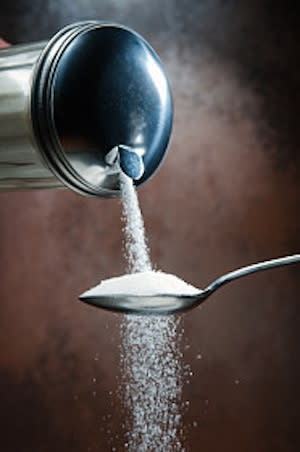The surprising truth about sugar
By
Sarah B. Weir

Posted Tue Sep 20, 2011 10:21am PDTMore from Green Picks blog
How much sugar can you eat without compromising your health? The American Heart Association (AHA) recommends women limit their consumption to less than 6 teaspoons per day. The AHA wants men to stick to less then 9 teaspoons, and for kids 4 to 8 years old, only 3 teaspoons of sugar are allowed.
Six teaspoons of sugar might seem like a lot if you visualize a pile of table sugar, but is it? One teaspoon of sugar is equal to 4 grams.
These foods each contain about 24 grams, or 6 teaspoons, of sugar:
3/4 of a can of Coke
Half a bag of Skittles
1/2 cup of Haagen-Daz sorbet
One 6-ounce container of Yoplait yogurt
3 1/2 tablespoons of Kraft Honey BBQ sauce
Kid's snacks can be loaded with sugar too:
Nature Valley chewy granola bar - 4 teaspoons
Stonyfield Organic smoothie - 9 teaspoons
Horizon Organic chocolate milk box - 5.5 teaspoons
Mott's Original applesauce - 5.5 teaspoons
Registered dietitian and spokesperson for the American Dietetic Association, Vandana Sheth, underscores how quickly sugar consumption creeps up: "For breakfast, if you drink a cup of coffee with one teaspoon of sugar and eat a bowl of lightly sweetened cereal, you have had your maximum for the day. "
Consequently, most of us, including children, eat much more than the recommended amount of sugar-Americans eat about 22 teaspoons of sugar per day on average (or nearly six times as much as young kids should consume). Of all age groups, 14 to 18 year olds have the biggest sweet tooths and eat the equivalent of about 34 teaspoons a day, the majority of which is consumed through soft drinks.
Sugar is like mother's milk
Donuts, cookies, candy, ice cream-it all tastes so good. In fact, we are biologically programmed to crave sweets. Mother's milk contains lactose, which has a double sugar hit of galactose and glucose. A predilection for sugary foods comes naturally to all babies.
So, if it tastes good and we are predisposed to eating it, why is it such a problem? The body copes fine with naturally occurring sugars-such as those contained in fruits, vegetables, and dairy products. Where we run into trouble is with "added sugars," which means sugar in various forms that is added to processed and manufactured foods. Added sugars include regular table sugar, high fructose corn syrup, maltose, sugar cane syrup, fruit juice concentrate, molasses, and other sweeteners that are chemically similar to each other and have virtually the same effect on the body. These substances contain calories with no nutritional value.
Added sugars, added disease
The overconsumption of added sugar has many negative effects on our bodies. According a study published by the American Heart Association in 2010, it can lead to obesity and cardiovascular disease, both of which are epidemic in the United States. The study also points out a growing body of research that indicates too much sugar is linked to high blood pressure. Plus, sugar causes tooth decay. A 2010 study published in the journal Diabetes Care reported that people who drink one 12-ounce soft drink a day have a 15% greater chance of developing type 2 diabetes and people who drink two soft drinks a day have a 26% greater chance.
How to read labels
Cutting back can be difficult since sugars are added to many processed foods. Sheth recommends that you try to "enjoy foods in their natural state"-choose whole fruit over fruit cocktail or juice, for example, and read labels closely. Determining how much added sugar a product contains is tricky because manufacturers are not required to distinguish between naturally occurring sugars and added sugars on nutritional labels.
The Harvard School of Public Health suggests skipping foods that have any form of sugar close to the top of the ingredients list since ingredients are listed in order by weight. They also say to watch out for foods that include more than one type of added sugar in their ingredients.
When it comes to sugar, it's very easy to have too much of a good thing. Watch where and how you're getting it so you can make those 6 to 9 teaspoons of sugar count.
